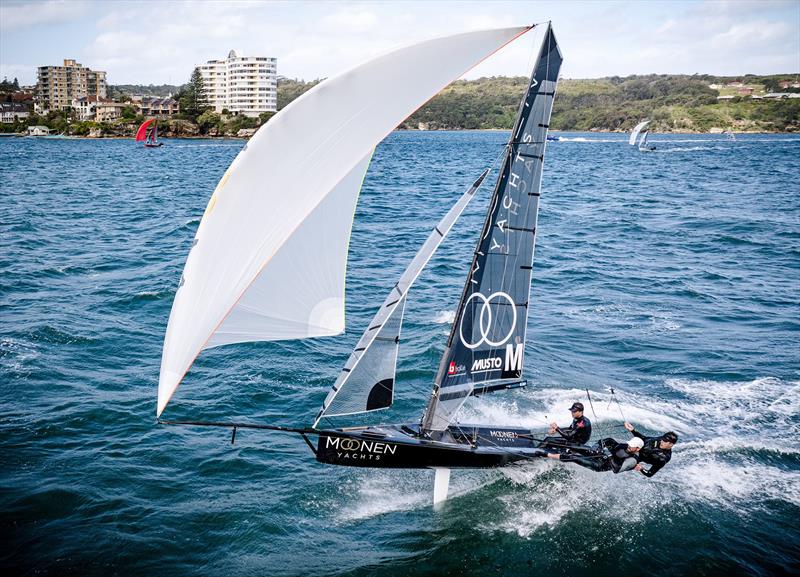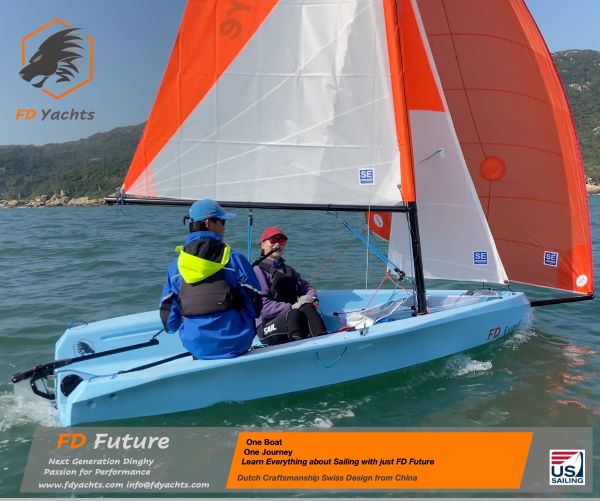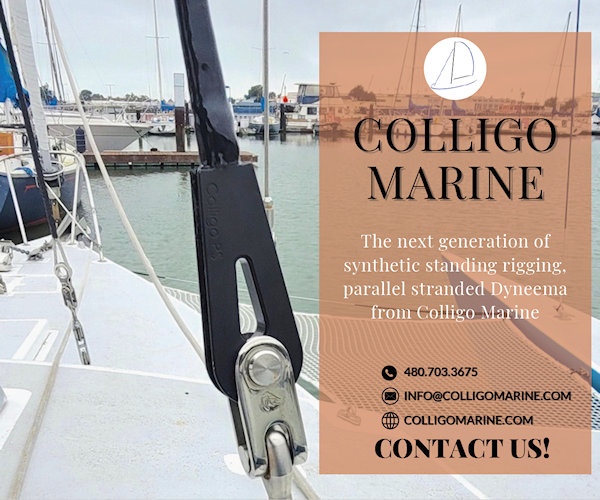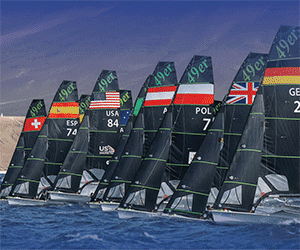
Manly’s Road to Development
by Mark Jardine 26 Nov 12:00 PST

Moonen Yachts – Skipper Daniel Turner – Club Championship / Crews Trophy © SailMedia


The Manly 16ft Skiff Sailing Club is a success in the context of reduced youth sailing support in Australia. With the absence of an Australian team at the last two World Sailing Youth Championships, the desire to choose competitive sailing over various other sports is lessened. Nonetheless, the Manly club is making headway against this trend and achieving success.
The club is focused on developing and fostering sailing talent through its pathway, aiming for them to become future 16ft Skiff sailors. Their goal is to become the leading sailing club in Australia, with a fleet of 90 skiffs and over 1,000 individuals sailing each season.
Michael Childs, the club’s Commodore, mentioned, “Our club’s priorities are clear: to promote the growth of 16ft Skiff sailing in our community. Naturally, part of that is the pathway, and our strength lies in guiding sailors through their entire journey into the senior division. We begin with the very young in the Manly Junior class, which offers a fun and engaging introduction to sailing, moving them through to Flying 11s, and then advancing to high-performance sailing with the 13ft Skiff. We believe this pathway promotes sailing development while ensuring our kids have fun and are challenged, ultimately leading them to the senior skiff division, which is our mission: to cultivate 16ft Skiff sailors.”
To measure the success of this pathway, it’s essential to look at those who’ve progressed through it. Sally Darmanin shares her experience: “All three of my kids have gone through the 4 boat pathway, starting as young as primary school, and they’re still sailing into their thirties. We aren’t a family of sailors; we got involved through friends and engaged in the juniors, inviting more people to join in. Having two people on a boat allows for different generations to sail together, encouraging their school friends to participate. A ‘big kid’ on board helps novices focus on learning their roles in a supportive environment. That’s the charm of the Manly 16s.”
Graham Biehl, Manly’s Sailing Manager, highlighted the effectiveness of double-handed sailing at the club: “Beginning in double-handed dinghies encourages young sailors to join with a friend, easing their nerves since they have someone to sail with. We recently launched a learn-to-sail program at our other club, St George Sailing Club. After reviewing various learn-to-sail platforms, we realized we have a double-handed boat, the Manly Junior. So we simplified some sails to make it more accessible.”
“We tested a modified sail plan last winter, featuring a mainsail only, similar in size to Opti and Sabot. We successfully paired two kids in this specially designed two-handed boat. As their skills improve, we add a jib, then a spinnaker, followed by a larger mainsail. So far, they love it, as they can sail with a friend, which fosters a lifelong passion for sailing.”
Sailors receive coaching with tailored strategies for those aiming for high competition and those more recreational. Some excel under competition pressure while others seek fun.
“When considering how children enter our fleet and sailing overall, they do so at various ages and stages. Some join the Manly Juniors young, others at older ages, some without experience, and others with prior exposure,” said Michael.
The Commodore continued, “Every child is unique and they seek different experiences. Some go out solely to beat their friends, while others enjoy the water and develop their passion for sailing. Our goal is to support this; we offer training and development for those wanting to pursue sailing more seriously while allowing our juniors to enjoy sailing with friends.”
With numerous activities at the club, structure is essential. Sailing manager Graham outlined the organization: “Throughout our sailing season, we have four days dedicated to organized sailing. Tuesday afternoons are for Manly Junior training with two coaches. Flying 11 training is on Wednesday afternoons with two coaches as well. Saturdays feature races for 13ft and 16ft Skiffs, without coaches, while Sundays include Manly Juniors racing in the morning and Flying 11s in the afternoon. Coaches are available even on race days because it’s also a learning environment. The club is so supportive, providing free coaching to all enrolled kids; they just need to appear.”
Currently, all boats are privately owned, but the club is exploring options for a club-owned fleet to enhance accessibility, as Graham explained: “Originally from the US, I’m advocating for a club-owned program at the ground level with the Manly Junior (MJ) since many do not stay with the MJ long enough to justify buying a boat – the newest MJ in Australia is possibly six years old, with no current production. There’s a fantastic opportunity to expand the class both at Manly and regionally. We aim to pioneer by financing club-owned boats, allowing people to join us without heavy investment in purchasing or storage. Just come and sail.”
While Australian Sailing has decided against fielding a Youth Sailing Championships team, Graham views the Manly pathway as distinct from the global youth pathway classes, stating, “Regardless of Australian Sailing’s decisions regarding youth programs, our established pathway has been in place for a long time, and our classes don’t necessarily align with the Olympic route.”
“We frequently attract sailors who prefer not to pursue the competitive route, recognizing a more community-focused, enjoyable path. We see many Opti kids burned out by age 14 or 15, often unable to transition, but we don’t face that challenge. We have kids participating in Manly Juniors, Flying 11s, and even 13ft Skiffs simultaneously, enjoying themselves on the water while remaining competitive and learning.”
The two clubs are supported by successful restaurants, catering mostly to members who are not sailors but understand the club’s objectives, as described by Michael: “Our club operates a very successful Bistro, which generates most of our revenue. Emphasizing our previous comments, our main aim is to increase 16ft Skiff sailing in our communities, so any profits we make ensure the club’s sustainability, the future of sailing, and aid individuals entering and remaining in the sport.”
The club collaborates with SailMedia to film their races, streamed in the Bistro, along with reels of junior sailing.
“It is a restaurant, but we maintain our focus as a sailing club. Sponsoring boats presents an excellent advertising opportunity for local markets,” Michael noted.
Graham elaborated, “We see media as critical for making sailing financially sustainable. A significant portion of our restaurant profits is allocated to what we call prize money, offered to teams that register and compete with us. It accumulates throughout the season, enabling teams to use it for refurbishing or purchasing new boats and replacing equipment.”
“The media also plays a key role. Skiffs have never been strictly sail number-type boats; they’ve always been associated with sponsorships or logos. It’s an important advertising platform for us. Occasionally, we’ve secured small sponsors for various events thanks to our media coverage. We believe this is a crucial piece of the puzzle.”
Could this model be successful at other clubs? Graham believes it can: “I’m highly impressed by this structure and believe more clubs should embrace it. While it may not have to replicate our exact model, I strongly advocate for it. Many clubs offer fantastic learn-to-sail programs, transitioning kids into Optis, but a large gap often follows Opti sailing, leaving kids unsure of their next steps.
“By integrating another boat as part of that transition, it could help retain kids longer, rather than losing them to other activities. This approach is definitely worth considering. Returning to Michael’s earlier focus, our club’s constitution and our purpose are so compelling that it’s hard to dispute. Showcasing success from ages six to sixty demonstrates that our system works.”
Success is difficult to contest, and it was motivating to engage with Michael, Sally, and Graham at the Manly 16ft Skiff Club, which exemplifies a genuine sailing achievement.
Mark Jardine
Sail-World.com and YachtsandYachting.com Managing Editor


